 W
WMontmartre is a large hill in Paris's 18th arrondissement. It is 130 m (430 ft) high and gives its name to the surrounding district, part of the Right Bank in the northern section of the city. The historic district established by the City of Paris in 1995 is bordered by rue Caulaincourt and rue Custine on the north, rue de Clignancourt on the east, and boulevard de Clichy and boulevard de Rochechouart to the south, containing 60 ha. Montmartre is primarily known for its artistic history, the white-domed Basilica of the Sacré-Cœur on its summit, and as a nightclub district. The other church on the hill, Saint Pierre de Montmartre, built in 1147, was the church of the prestigious Montmartre Abbey. On August 15, 1534, Saint Ignatius of Loyola, Saint Francis Xavier and five other companions bound themselves by vows in the Martyrium of Saint Denis, 11 rue Yvonne Le Tac, the first step in the creation of the Jesuits.
 W
WThe 18th arrondissement of Paris is one of the 20 arrondissements of the capital city of France. In spoken French, this arrondissement is referred to as dix-huitième.
 W
WAcadémie de La Palette, also called Académie La Palette and La Palette,, was a private art school in Paris, France, active between 1888 and 1914, aimed at promoting 'conciliation entre la liberté et le respect de la tradition'.
 W
WAmélie is a 2001 romantic comedy film directed by Jean-Pierre Jeunet. Written by Jeunet with Guillaume Laurant, the film is a whimsical depiction of contemporary Parisian life, set in Montmartre. It tells the story of a shy waitress, played by Audrey Tautou, who decides to change the lives of those around her for the better while struggling with her own isolation. The film also features an ensemble cast of supporting roles, including Mathieu Kassovitz, Rufus, Lorella Cravotta, Serge Merlin, Jamel Debbouze, Claire Maurier, Clotilde Mollet, Isabelle Nanty, Dominique Pinon, Artus de Penguern, Yolande Moreau, Urbain Cancelier, and Maurice Bénichou.
 W
WBal des Quat'z'Arts was a Parisian annual ball, the first held in 1892 and the last in 1966. The event was organised by Henri Guillaume, Professor of Architecture at the École nationale supérieure des Beaux-Arts for students of architecture, painting, sculpture, and engraving. The first ball was held in 1892 in Montmartre. It was modest when compared with later ones, and it was considered a success, though it was immediately put into the hands of organizers. The second event was a costume ball held 9 February 1893 at the Moulin Rouge; along with merriment and drinking. Nude models walked about as living paintings and a nude woman was noted to be standing on a table at midnight. A lawsuit arose thereafter.
 W
WThe Bateau-Lavoir is the nickname of a building in the Montmartre district of the 18th arrondissement of Paris that is famous in art history as the residence and meeting place for a group of outstanding early 20th-century artists, men of letters, theatre people, and art dealers. It is located at No. 13 Rue Ravignan at Place Emile Goudeau, just below the Place du Tertre.
 W
WLa Bohème is a song written by French songwriter Jacques Plante and Armenian-French artist Charles Aznavour. It is Aznavour's signature song, as well as one of the most popular French-language songs and a staple of French chanson.
 W
WCabaret de l'Enfer was a famous cabaret in Montmartre, founded in November 1892 by Antonin Alexander and demolished in 1950 to allow for the expansion of a Monoprix supermarket. The Cabaret de L'Enfer was the counterpart to The Cabaret du Ciel, another cabaret which shared the same address on the Boulevard de Clichy. Antonin Alexander was the creator, director, and host of the twin ventures.
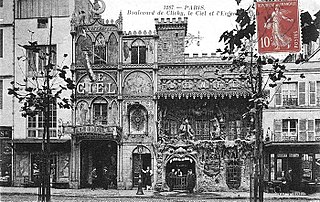 W
WThe Cabaret du Ciel was a well-known cabaret in the Montmartre district of Paris. The Cabaret du Ciel was an early version of modern theme restaurants, with a theme centered around celestial concepts connected to the afterlife in Paradise. The cabaret was located next to the Cabaret de L'Enfer at the same address at 53 Boulevard de Clichy.
 W
WCabaret du Néant was a cabaret in Montmartre, Paris, founded in 1892. The Cabaret du Néant was an early pioneer of the modern theme restaurant and dealt with various aspects of mortality and death. The dark theme of the cabaret included magic tricks and illusions focusing on morbid subjects.
 W
WThe Café des 2 Moulins is a café in the Montmartre area of Paris, located at the junction of Rue Lepic and Rue Cauchois. It takes its name from the two nearby historical windmills, Moulin Rouge and Moulin de la Galette. The interior consists of a bar area and multiple small tables.
 W
WCafé du Tambourin was a restaurant in Paris, France. Owned by Agostina Segatori, it was first located at 27 rue de Richelieu, and then in March 1885 reopened at 62 Boulevard de Clichy. Famous painter, Jules Chéret, made a poster for the Cabaret at the reopening. The Café had an original decor in which Segatori hung works given to her by Edward Dantan.
 W
WLe Chat Noir was a nineteenth-century entertainment establishment, in the bohemian Montmartre district of Paris. It was opened on 18 November 1881 at 84 Boulevard de Rochechouart by the impresario Rodolphe Salis, and closed in 1897 not long after Salis' death.
 W
WThe Cirque Medrano is a French circus that was located at 63 Boulevard de Rochechouart, at the corner of rue des Martyrs, in the 18th arrondissement at the edge of Montmartre in Paris. It was originally called Cirque Fernando. The title "Cirque Medrano" is still active today: it is now a successful French traveling circus.
 W
WThe Vigilance Committee of Montmartre was a political association and provisional administrative organization established on the Rue de Clignancourt shortly before the Siege of Paris (1870–1871). Closely affiliated with the International Workingman's Association, its members had strong connections with the various anarchist and socialist tendencies of the time, particularly those represented by Karl Marx, Mikhail Bakunin, and Auguste Blanqui.
 W
WÉlysée Montmartre is a music venue located at 72 Boulevard de Rochechouart, Paris, France. It opened in 1807, burned down in 2011, reopened in 2016, and has a capacity of 1,380 patrons. The nearest métro station is Anvers.
 W
WThe Musée-Placard d'Erik Satie was a small museum dedicated to composer Erik Satie (1866–1925). It was located in the 18th arrondissement of Paris at 6, rue Cortot, Paris, France.
 W
WThe Espace Dalí is a permanent exhibition in France devoted to Salvador Dalí consisting mainly of sculptures and engravings. The museum, near the Place du Tertre in the Montmartre district of Paris, has around 300 original artworks. The collection features mainly three-dimensional sculptures of Dalí's best known surrealistic paintings.
 W
WLapin Agile is a famous Montmartre cabaret, at 22 Rue des Saules, 18th arrondissement of Paris, France.
 W
WLe Trianon is a theatre and concert hall in Paris. It is located at 80, boulevard de Rochechouart, in the 18th arrondissement of Paris, at the foot of the hill of Montmartre.
 W
WThe Line is a 2009 play by British dramatist Timberlake Wertenbaker about the relationship between Edgar Degas and Suzanne Valadon. Set in " the intimate, if quarrelsome world of Montmartre", at the play's heart are " a leading artist, a protegee and a clash between traditions, lifestyles and eras." The 2009 London production of the play starred Henry Goodman as Degas and Sarah Smart as Valadon.
 W
WThe Lollipop Shoes is a 2007 novel by Joanne Harris—a sequel to her best-selling Chocolat. Darker than Chocolat—more openly mystical—this story is set between Halloween and Christmas.
 W
WMaison Souquet is a 5-star hotel, part of Maisons Particulieres Collection, located at 10, rue de Bruxelles in Paris, on the outskirts of Montmartre. The hotel is inspired by the Parisian brothels from the Belle Époque period. Maison Souquet is decorated by the French designer Jacques Garcia.
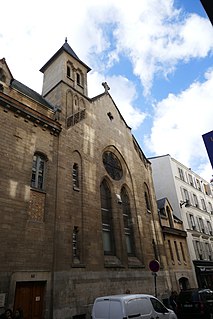 W
WThe hill of Montmartre became a place of popular pilgrimage after a chapel was erected by the people of Paris, around 475, where Saint Denis, the first bishop of Paris, was martyred. In the ninth century, the chapel, which had become ruined, was rebuilt. Archaeological excavations indicate that many Christians were buried in Montmartre. Their bones were gathered in a quarry on the side of the hill: the Martyrium or champ des morts.
 W
WThe Montmartre paintings are a group of works that Vincent van Gogh made in 1886 and 1887 of the Paris district of Montmartre while living there, at 54 Rue Lepic, with his brother Theo. Rather than capture urban settings in Paris, van Gogh preferred pastoral scenes, such as Montmartre and Asnières in the northwest suburbs. Of the two years in Paris, the work from 1886 often has the dark, somber tones of his early works from the Netherlands and Brussels. By the spring of 1887, van Gogh embraced use of color and light and created his own brushstroke techniques based upon Impressionism and Pointillism. The works in the series provide examples of his work during that period of time and the progression he made as an artist.
 W
WMontmartre Abbey was a 12th-century Benedictine monastery established in the Montmartre district of Paris within the Diocese of Paris.
 W
WThe Cemetery of Montmartre is a cemetery in the 18th arrondissement of Paris, France, that dates to the early 19th century. Officially known as the Cimetière du Nord, it is the third largest necropolis in Paris, after the Père Lachaise Cemetery and the Montparnasse Cemetery.
 W
WThe Montmartre Funicular is an inclined transport system serving the Montmartre neighbourhood of Paris, France, in the 18th arrondissement. Operated by the RATP, the Paris transport authority, the system opened in 1900, and was entirely rebuilt in 1935 and again in 1991.
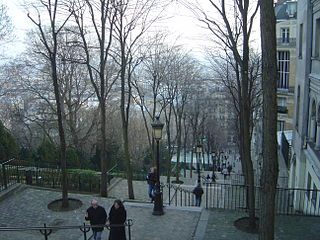 W
WThe Rue Foyatier is a street on the Montmartre butte ("outlier"), in the 18th arrondissement of Paris. Opened in 1867, it was given its current name in 1875, after the sculptor Denis Foyatier (1793–1863). One of the most famous streets in Paris, it consists of flights of stairs giving access to the top of the hill, the Sacré-Cœur Basilica, and the other attractions of the upper-Montmartre neighborhood. The Montmartre funicular runs alongside it.
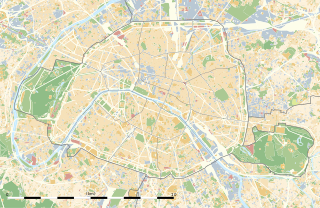 W
WThe Moulin de la Galette is a windmill and associated businesses situated near the top of the district of Montmartre in Paris. Since the 17th century the windmill has been known for more than just its milling capabilities. Nineteenth-century owners and millers, the Debray family, made a brown bread, galette, which became popular and thus the name of the windmill and its businesses, which have included a famous guinguette and restaurant. In the 19th century, Le Moulin de la Galette represented diversion for Parisians seeking entertainment, a glass of wine and bread made from flour ground by the windmill. Artists, such as Renoir, van Gogh, and Pissarro have immortalized Le Moulin de la Galette; likely the most notable was Renoir's festive painting, Bal du moulin de la Galette.
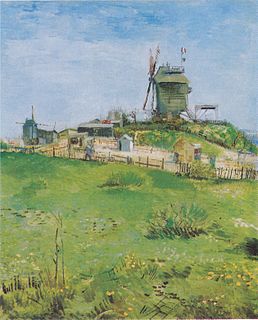 W
WLe Moulin de la Galette is the title of several paintings made by Vincent van Gogh in 1886 of a windmill, the Moulin de la Galette, which was near Van Gogh and his brother Theo's apartment in Montmartre. The owners of the windmill maximized the view on the butte overlooking Paris, creating a terrace for viewing and a dance hall for entertainment.
 W
WThe Musée de Montmartre is located in Montmartre, at 8-14 rue Cortot in the 18th (XVIII) arrondissement of Paris, France. It was founded in 1960 and was classified as a Musée de France in 2003. The buildings were formerly the home of several famous artists, including Pierre-Auguste Renoir and Suzanne Valadon.
 W
WPlace Dalida is the square of Montmartre, Paris, dedicated to French music icon Dalida. Many fans and tourists visit to pay tribute to the French icon.
 W
WThe Place du Tertre is a square in the 18th arrondissement of Paris, France. Only a few streets away from Montmartre's Basilica of the Sacré Cœur and the Lapin Agile, it is near the summit of the city's elevated Montmartre quarter. Place du Tertre was the heart of the prestigious Benedictine Montmartre Abbey, established in 1133 by King Louis VI. Montmartre Abbey thrived through the centuries and until the French revolution under the patronage of the Kings of France. Place du Tertre was opened to the public in 1635 as Montmartre village central square. From the end of the 18th century until World War One, the whole Montmartre Boheme could been seen here: painters, songwriters and poets.
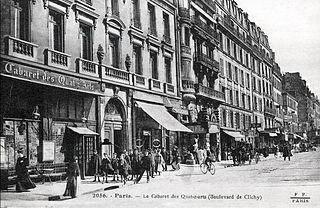 W
WCabaret des Quat'z'Arts was a venue at 62 Boulevard de Clichy, in Paris, France. The interdisciplinary mixture of the arts created avant-garde collaborative performances. Similar to Le Chat Noir, the Quat'z'Arts was a gathering place for artists, composers, musicians, performers, poets, illustrators, and theater critics, attracting newcomers such as Pablo Picasso and Apollinaire. It provided space for permanent and temporary art exhibits by the likes of Emile Cohl, Jules-Alexandre Grün, Charles Léandre, Georges Redon, Lucien-Victor Guirand de Scévola, Henri de Toulouse-Lautrec, Louis Abel-Truchet, and Adolphe Willette.
 W
WR-26 was an artistic salon regularly held at the private residence of socialites Madeleine, Marie-Jacques and Robert Perrier at 26 Rue Norvins in the Montmartre district of Paris. First convened on 1 January 1930, the salon became a meeting ground for many creative luminaries of the next eighty years, including singer Josephine Baker, architect Le Corbusier and musician Django Reinhardt.
 W
WThe Rue Foyatier is a street on the Montmartre butte ("outlier"), in the 18th arrondissement of Paris. Opened in 1867, it was given its current name in 1875, after the sculptor Denis Foyatier (1793–1863). One of the most famous streets in Paris, it consists of flights of stairs giving access to the top of the hill, the Sacré-Cœur Basilica, and the other attractions of the upper-Montmartre neighborhood. The Montmartre funicular runs alongside it.
 W
WThe Basilica of the Sacred Heart of Paris, commonly known as Sacré-Cœur Basilica and often simply Sacré-Cœur, is a Roman Catholic church and minor basilica, dedicated to the Sacred Heart of Jesus, in Paris, France.
 W
WSaint-Pierre de Montmartre is one of the oldest surviving churches in Paris but the lesser known of the two main churches in Montmartre, the other being the more famous 19th-century Sacré-Cœur Basilica. Saint-Pierre de Montmartre, built in 1147, was the church of the prestigious Montmartre Abbey.
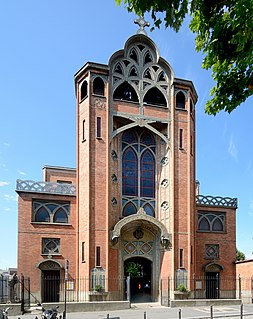 W
WSaint-Jean de Montmartre is a Roman Catholic parish church located at 19 Rue des Abbesses in the 18th arrondissement of Paris.
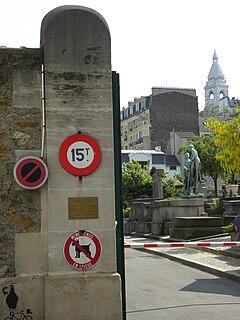 W
WSaint-Vincent Cemetery is a cemetery in the 18th arrondissement of Paris.
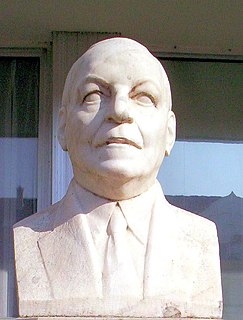 W
WDas Veilchen vom Montmartre is an operetta in 3 acts by Hungarian composer Emmerich Kálmán. The libretto was written by Julius Brammer and Alfred Grünwald. It premiered in Vienna at the Johann Strauß-Theater on 21 March 1930.
 W
WThe Musée de la Vie romantique stands at the foot of Montmartre hill in the 9th arrondissement of Paris, 16 rue Chaptal, Paris, France in an 1830 hôtel particulier facing two twin-studios, a greenhouse, a small garden, and a paved courtyard. The museum is open daily except Monday. Permanent collections are free. An admission fee is charged for temporary exhibitions. The nearest métro stations are Pigalle, Blanche, Saint-Georges, and Liège.
 W
WThe Wall of Love is a love-themed wall of 40 square metres (430 sq ft) in the Jehan Rictus garden square in Montmartre, Paris, France. The wall was created in 2000 by calligraphist Fédéric Baron and mural artist Claire Kito and is composed of 612 tiles of enamelled lava, on which the phrase 'I love you' is featured 311 times in 250 languages. Each tile is 21 by 29.7 centimetres.